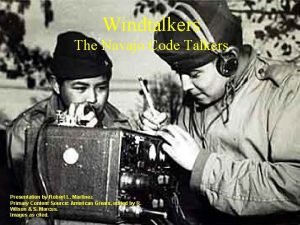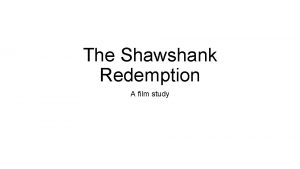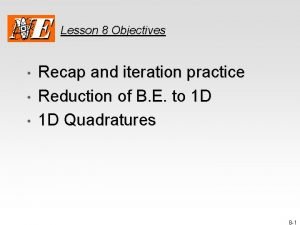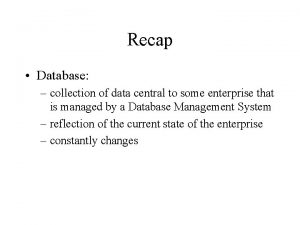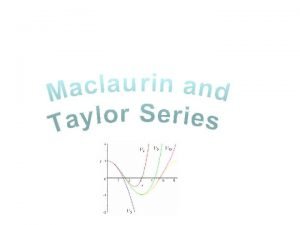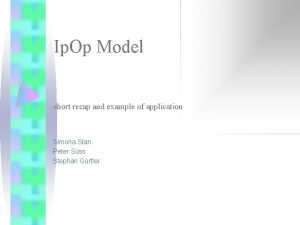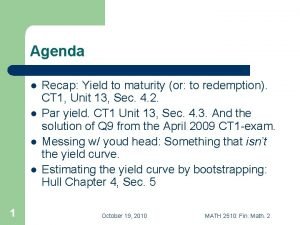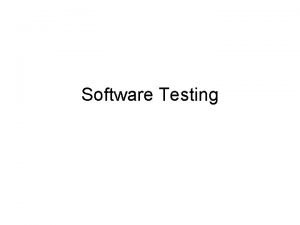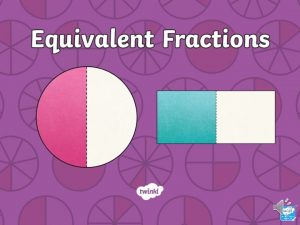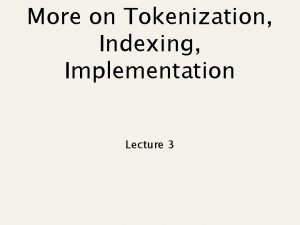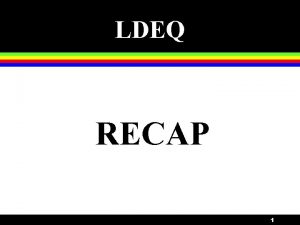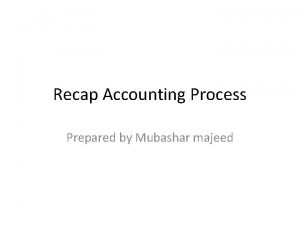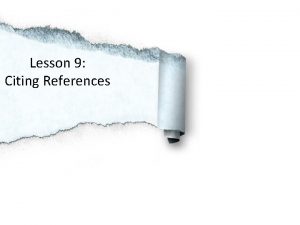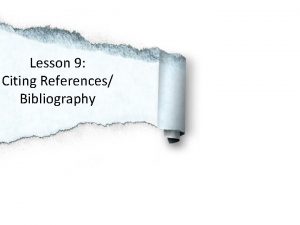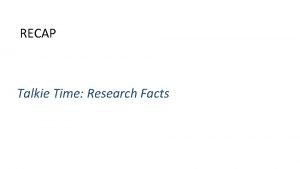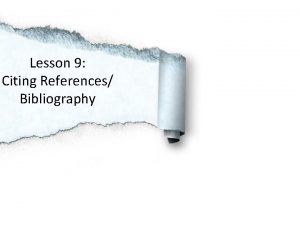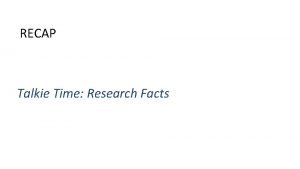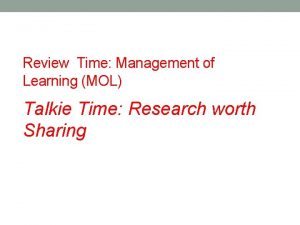TALKIE TIME RECAP OF THE LAST LESSON Learning




























- Slides: 28

TALKIE TIME RECAP OF THE LAST LESSON

Learning Objectives: 1. Finds the answers to research questions (CG) 2. Gathers and analyze the data using appropriate techniques (CG) 3. Presents the data; gives analysis and interprets the data (Addendum)

Pre-Activity : Application: Produce a Table and Discussion

THE HEPATOPROTECTIVE EFFECT OF NEEM (Azadirachta indica) LEAF CRUDE EXTRACT ON ACETAMINOPHEN-INDUCED HEPATOTOXICITY IN MALE RABBITS (Oryctolagus cuniculus)

HOW ABOUT IN APPLIED RESEARCH

Drainage Management System Using Ultrasonic Sensors

THE PROBLEM Statement of the Problem The researcher sought to innovate a new drainage system management with use of ultrasonic sensor. The main aim of this study is to provide a real-time information on the drainage condition and water level detection. Specifically, the study sought to answer the following questions: 1. What is the Operation Design of the researcher-made drainage management system? 2. What Materials and Procedures are used the researcher-made drainage management system? 3. How functional is the proposed design based on its purpose? Assumption: The researcher-made drainage management system is effective in providing a real-time information on the drainage condition and water level detection.

Results and Discussion

I-A. The Operation Design – Block Diagram The operation design of the proposed drainage management system using ultrasonic sensors is to locate clogs for an early flood response. Figures 1 illustrates the block diagram of the ultrasonic sensor of the design project. Figure 1. Block diagram of the ultrasonic sensor

I-B. Operation Design - The Programming The researcher collected different programs for each sensor from the Arduino website. The codes were compiled and modified to fit the use to be obtained using the Arduino 1. 6. 9 software. Extensive revision and analysis were done in order to achieve the expected code. Figure 2 illustrates the program flow chart of the whole project.

Figure 2. Program Flow Chart

I-C. Operation Design – The Set Up Mechanism of Ultrasonic Sensor The Ultrasonic sensor detects the distance of any object without the sense of touch. It is set into repeatable mode, meaning it will continue to detect any object’s distance until it ends. The sensor is given a ten-second calibration time and after that, it runs. This sensor contains lenses that determines its detection range. It is said to have a minimum and maximum range of 2 to 400 centimeters according to the manual. The sensor is then set to its maximum range.

Figure 3. Ultrasonic Sensor Schematic Diagram

According to the program, the sensor will only send a high signal once the distance of uneven water levels are detected. The system was then tested in various situations with a clog in different areas of the drainage system. This is to ensure the accuracy of the whole system. An LED, along with a piezo element buzzer, is paired up with each Ultrasonic set-up that turns on when the coniditon is met. Thus, if an LED and buzzer emit light aand sound respectively, then it must mean there is a block within its area.

Figure 4. Ultrasonic Range Finder

II. Materials and Procedures : The researcher will use the following materials: 3 HC-SR 04 Ultrasonic Sensors Male-Male Connectors Male-Female Connectors Female-Female Connectors USB Cable A to B Arduino Mega 2560 Microcontroller 3 Piezo Element Buzzer 3 LEDs Arduino Software (version 1. 6. 9) Soldering iron Lead Sealant 32 in x 6. 5 in x 13. 5 in Case (Prototype Set-Up) The researcher obtained the materials needed from 3 M Electronix in Basak-Marigondon Road, Lapu-Lapu City, from Bitstoc Electronics in Tres Borces Padres Street, Cebu City, and unused materials from School Stockroom.

1 x HC-SR 04 module

VCC = +5 VDC Trig = Trigger input of Sensor Echo = Echo output of Sensor GND = GND

The Arduino Mega 2560 is a microcontroller board based on the ATmega 2560 (datasheet). It has 54 digital input/output pins (of which 14 can be used as PWM outputs), 16 analog inputs, 4 UARTs (hardware serial ports), a 16 MHz crystal oscillator, a USB connection, a power jack, an ICSP header, and a reset button. It contains everything needed to support the microcontroller; simply connect it to a computer with a USB cable or power it with a AC-to-DC adapter or battery to get started. The Mega is compatible with most shields designed for the Arduino Duemilanove or Diecimila.

Figure 6. 3. Programming of the First Ultrasonic Sensor

Figure 6. 5. Programming of the Third Ultrasonic Sensor

Figure 8. Primary Set Up of the Program

Figure 9. 1. Creation of the Prototype Drainage 1

Figure 10. 3. Creation of the Drainage Prototype 2

III. Functionality Test LOCATION OF THE BLOCK Sector 1 LOCATION OF THE BLOCK Sector 2 Depth of Set-Up 27 cm READINGS (in cm) 1 st Sensor 17 2 nd Sensor 3 rd Sensor 27 27 Conclusion Block in Sector 1 was detected READINGS (in cm) 1 st 2 nd 3 rd Sensor 27 16 27 Conclusion Block in Sector 2 was detected

As the program coded runs, the researcher observes that the system runs all together. The operation of the drainage management system set-up is based on the readings of the ultrasonic sensors. The data collected by the ultrasonic sensors are fed into the system to be displayed in a serial monitor. Once an unequal reading is found between two sensors (i. e. , Sensor A is greater than Sensor B), and equal reading is found between another two sensors (i. e. , Sensor B is equal to Sensor C), then there is a clog or block in the system, therefore the function of this system is to detect clogs based on the ultrasonic sensors’ readings and their conditions programmed. As an unequal reading is gathered from two different areas/ultrasonic sensors, an LED and Piezo element buzzer is activated to dictate a block in the system. It is observed that the system is delayed by onefourth of a second or 25 milliseconds.

APPLICATION: Present a mock up data. (Individual)

ROBOTRASH 2. 0: WASTE SEGREGATOR ROBOT Statement of the Problem The engineering research will produce a Robot that segregates trash. Specifically, it answers the following questions. 1. What program design can be utilized to produce the waste segregator robot? 2. What materials and Testing Procedures can be developed to produce the Robot? 3. How functional is the Robot in segregating wastes? 4. What is the perception of the selected samples who used the Robot?
 Mc millan research
Mc millan research Windtalker walkie talkie
Windtalker walkie talkie Recap from last week
Recap from last week Cuadro comparativo e-learning b-learning m-learning
Cuadro comparativo e-learning b-learning m-learning Shawshank redemption film study
Shawshank redemption film study Great gatsby ch8 summary
Great gatsby ch8 summary Segmented pricing
Segmented pricing What is the purpose of an iteration recap?
What is the purpose of an iteration recap? Recap intensity clipping
Recap intensity clipping 60 minutes recap
60 minutes recap Recap database
Recap database Bracket power rule
Bracket power rule Sample script for recapitulation
Sample script for recapitulation Recap introduction
Recap introduction Questions for act one of the crucible
Questions for act one of the crucible Pontius pilate the crucible
Pontius pilate the crucible Logbook recap example
Logbook recap example Ytm recap
Ytm recap Black box recap
Black box recap Fractions recap
Fractions recap Recap
Recap X and y axis in bar graph
X and y axis in bar graph Recap indexing scans
Recap indexing scans Let's have a quick recap
Let's have a quick recap Recap poster
Recap poster Public transportation essay
Public transportation essay Ldeq recap
Ldeq recap Romeo and juliet act 1 summary
Romeo and juliet act 1 summary Recap accounting
Recap accounting

